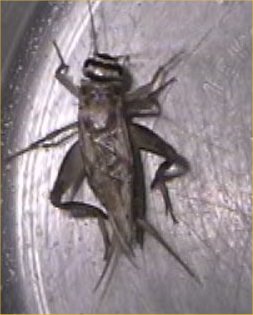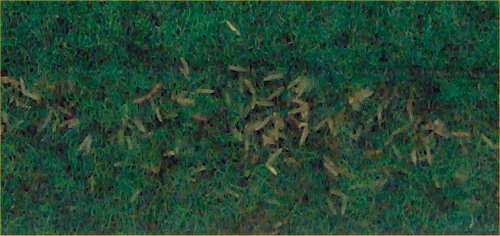 |
 |
|
|
Last Updated: 11/1/13


Introduction and Feeder Insects
Animals that Eat Crickets
Cricket Setups
Feeding and Watering
Breeding
Maintenance
Links
Other Insect Pages:
Caring for various kinds of mealworms
Controlling ants without killing your crickets
Roaches - an alternative for large reptiles (less messy and
smelly, less likely to die than crickets)
This page is about caring for the common house crickets which are raised to feed to various animals as "live food." Much of this information will also work for other insects whether they are used to feed others or kept as pets. On 11/2/04, I had seven containers of live insects: adult crickets, juvenile crickets that bred here, adult king mealworms and giant mealworms, juvenile giant mealworms that bred here, baby regular mealworms that bred here, regular mealworms, and adult mealworms (regular mealworm and king mealworm pupae and beetles). Some of these animals would be fed to my lizard, hedgehogs, or chickens but most got to live out their entire lives like pets. More information on mealworms can be found on my mealworm page. As of 10/21/13, I have four containers of "feeder" insects including adult crickets, larval mealworms, adult mealworms (just a few beetles), and roaches. My lizard and hedgehogs are all gone. I feed crickets and mealworms to my turtles and mealworms to the chickens.
I have taken much of what is written here from my sailfin lizard page. I kept what was there on that page as well. I also copied a lot of this from my mealworm page but read and altered it to fit crickets.
There are three basic sizes of crickets: pinhead (newborn), small, and large (adult). Smaller animals eat the smaller sizes. The larger the animal, the further down this list they can go for food choices.
P = pinheads- from about 2 mm at birth to 9 mm or so
S = small crickets - from about 1 to 2 cm
L = large crickets - from about 2 to 4 cm (not including ovipositor; females are larger)
The following are some of the animals that will eat crickets. Some of these animals have no problem going for live crickets while others require the slower dead crickets.
Birds:
Chickens, turkeys, guinea
fowl, peafowl, quail, chukar, pheasant, bluebirds, songbirds, and well most birds!
Mammals:
Hedgehogs, shrews, moles, voles, bats, rats, and other
mammals that eat insects.
Reptiles:
Aquatic turtles of all sorts, box
turtles, tortoises, sailfin lizards, chameleons, fringe-toed
lizards, basilisks, water dragons, anoles, and well most
reptiles that eat bugs!
Amphibians:
Frogs, toads, newts, and salamanders of all sorts!
Fish:
Archers, goldfish, piranha, arrowana, and any big fish that eats bug meat!

Feeding them is called "gut loading." If I feed them good foods, then my lizard who would eat them would in turn be eating those foods that were inside the crickets.
I use plastic containers sold to hold fish and other small animals that do not belong in such small homes. These homes are fine for crickets though as they are much smaller. Sizes from one to three gallons are best, depending on the number you want to keep. For a breeding colony, you will need at least two containers. The lids have holes all over them.
You can also use any plastic or glass container. It MUST have multiple air holes with a mesh lid even better. Crickets will die off if they do not get enough circulation. For lots of crickets, using a big under-bed plastic storage tub works well. Also, aquariums work well. Be sure to include a lid with ventilation as crickets are pretty jumpy!
Larger cages and 10 gallon glass aquariums are also good. Provide pieces of cardboard egg crates, toilet paper rolls, and paper towel rolls for them to stand in and hide.
Kept in too small containers, crickets will die, and/or you will have to clean up often. Dead crickets REALLY stink!
Crickets should be kept out of direct light but not be kept in total darkness either. I put my containers under my lizard's 120 gallon aquarium, in the cabinet. I later had to move the containers to the basement as ants found the containers and could not be controlled. Keep crickets in an area with some ventilation and subdued lighting.
Foods that I offer my crickets:
Water:
To provide water for the crickets, I soak a paper towel and ring it out most of the way. I put a new one in the container every other day. The crickets suck water out of it. If you have more crickets, add more paper towels and add new ones daily. I leave the old, dry ones in until I clean the cages on Saturday morning. If you provide water in a dish, they will drown and make a mess. You can try to rely instead on wet sponges, fruits and vegetables with high water contents, or "cricket quencher" which is a polymer that insects can suck water out of. Without water, crickets will die shortly. There are also insect "water pillows" they are selling which you wet, and they retain water for the insects to drink. I have been using them, and they work well too.

You may wish to breed crickets to reduce the need to buy them. Also, sometimes it is hard to come by the pinhead baby crickets.
Adult females have a long black ovipositor. See the photos at the top of this page to see the difference in the sexes. For optimal breeding, keep about 3-4 times more females than males. As long as you have some females though, the sex ratio is not critical.
My crickets bred on their own in the lizard's cage which was warm and moist. Warmth and moisture are the keys to breeding crickets. Baby crickets left in with the lizard grew up fine (until I got to clean the cage) but if I tried to raise them separately, they grew really slowly (perhaps it was too cold). My female crickets liked to lay their eggs in the carpet in my lizard's tank. Putting a small piece of carpet (not plush but dense and short) in their breeding cage would probably work very well. The eggs are obvious, white/yellow, and not see-through. They are very long but not wide. The female will lay them in clumps from her ovipositor in a damp (but not wet) and dark spot. The newborns are easy to overlook or think to be some minute pest. In my experience, crickets grow pretty slowly.
In the summer of 2004, I bought a cricket breeding kit. It basically used slightly damp vermiculite and soil mix as a place for ovipositing eggs. I put a few males and half a dozen females into the kit but they quickly died as there was no ventilation even after I put some pinholes in the container which they said you did not need to do. So, I put the container of vermiculite into their main cage and left it there will all the dozens of crickets for a few weeks. The girls were sticking their ovipositors in like crazy. After a few weeks, I put the container of vermiculite into another container and waited. I had almost given up when the first babies started hatching two weeks later. After a week or so, I put the vermiculite back in with the adults and repeated the cycle a few times until I had more babies than I knew how to handle!
Once a week, I pick up the paper towel tubes and egg cartons and shake them into a container (I use a large plastic deli container). Then, I use a dixie cup to corner and pick up the rest of the live crickets in the cage and put them into the temporary container as well. The dead crickets, old food, waste, etc. as well as the old paper towel tubes are dumped in the trash. The container is washed and dried. I put in a wet paper towel that is squeezed out and a "water pillow." I sprinkle the baby oatmeal cereal and gutload food into one corner. Depending on whether it is a "bug day" or a "fruit and veggie" day for my lizard (and later turtle), I put in fruits and vegetables for the bugs as well. Then, I put in fresh paper towel tubes and egg carton. I pour the adult crickets back.
Cleaning containers with baby crickets:
After having bred a big batch of baby crickets, I found you cannot really clean their cage without causing mass mortality. If anyone has any ideas, please let me know. I basically just hardly ever cleaned the cages while they were young. On occasion, I would pour them into another container to clean their main 3-gallon cage out. Pinheads would end up bouncing all over the room and dozens would be squashed. Once up to a cm in size (takes a few months in my setups), then I could move them as I do adult crickets. It is quite an experience to have so many tiny crickets bouncing so high all over the place! On 7/24/05, Lucas told me that he lures baby crickets into bottle caps and then moves them in order to clean their tank.
Wow, I did a search on crickets and got more than 60,000 hits! Here are some of the best sites I found. I did not have time to read them all or visit even a fraction of what is out there though! These sites make mine seem like nothing!
Breeding crickets - this is an archived version as the site no longer exists.
Raising crickets - looks like a good site with some good photos and extreme details and innovations!
Cricket Forum - a good place to ask questions
Breeding crickets - this is an archived version as the site no longer exists.
Breeding the common house cricket
Breeding and raising the house cricket
Eggcartons.com - a place to buy lots of egg cartons that I use for crickets.
Breeding and Raising the House Cricket - this is an archived version as the site no longer exists.
Songs of Insects - singing crickets, katydids, and cicadas.
1
|
|
Return to the main insect page.
See the master index for the insect pages.

|

|
E-mail RobynCopyright © 1997-2026 Robyn Rhudy |

|
 |